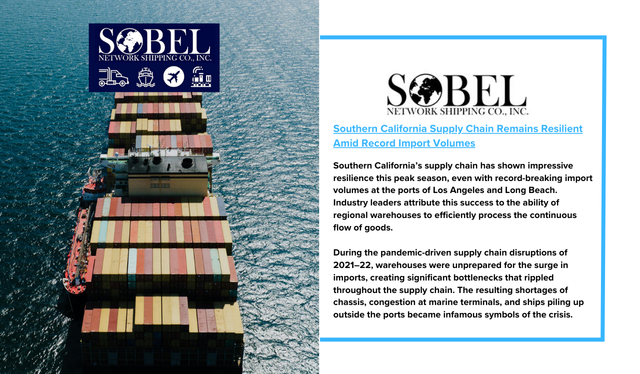Southern California’s supply chain has shown impressive resilience this peak season, even with record-breaking import volumes at the ports of Los Angeles and Long Beach. Industry leaders attribute this success to the ability of regional warehouses to efficiently process the continuous flow of goods.
During the pandemic-driven supply chain disruptions of 2021–22, warehouses were unprepared for the surge in imports, creating significant bottlenecks that rippled throughout the supply chain. The resulting shortages of chassis, congestion at marine terminals, and ships piling up outside the ports became infamous symbols of the crisis.
However, this year, the story is different. Warehouses across Southern California have maintained optimal staffing and equipment levels, helping to keep the supply chain moving smoothly. Scott Weiss, Vice President of Technical Sales at A.P. Moller Maersk, points to the steady flow of imports this spring and summer as a critical factor. “There used to be much more seasonality to imports. Now it’s more spread out,” he says. This consistent pace allows warehouses to operate at peak performance, avoiding the disruptions of the past.
Sal Ferrigno, Vice President of SSA Marine, echoes this sentiment. He notes that warehouse staffing is no longer an issue, with facilities now fully equipped to handle increased import volumes. In August alone, the Los Angeles-Long Beach port complex saw an all-time high of 849,806 TEUs of Asian imports, a 23.7% increase year over year, according to data from PIERS, an S&P Global product.
Near-Dock Surge Yards Provide Relief
A significant improvement since the pandemic has been the utilization of near-dock surge yards. These facilities offer temporary storage for inbound containers until they’re needed at warehouses or shipped eastward via train. This innovation has freed up valuable space at marine terminals, allowing them to handle the steady discharge of import containers without backups.
Sepehr Matinifar, Vice President of Logistics Services at the Wonderful Company, highlights that major retailers like Amazon and Walmart are heavy users of these near-dock storage yards. Mario Cordero, Executive Director of the Port of Long Beach, adds that surge yards like Pier S have been instrumental in maintaining low container dwell times, with the average for trucked containers at just under three days in August.
With fluid marine terminal operations, vessels can now berth and depart on schedule, preventing the vessel backlogs that became a regular feature during the COVID-19 pandemic. In contrast to January 2022, when a record 109 container ships were waiting offshore, the Marine Exchange of Southern California reports that 67 ships are scheduled to arrive at the LA-LB port complex this week, with all cargo moving smoothly through the system.
Improved Chassis Availability
Chassis shortages, a major issue during the pandemic, have also eased significantly. During the height of the disruptions, chassis-container units often sat idle for over 10 days, creating street congestion and reducing chassis availability. Now, the average street dwell time for 40-foot chassis has dropped to 5.9 days, well below the seven-day threshold that contributes to port congestion.
A contributing factor to the improved situation is that many drayage operators now own or lease their chassis, reducing their reliance on shared pools. This shift has enhanced the efficient use of chassis and reduced port delays.
Challenges Remain for Rail Operations
Despite these improvements, the intermodal rail sector continues to face challenges. In August, the average dwell time for rail containers at Los Angeles-Long Beach terminals was 8.2 days, the highest since November 2022. Rail container backlogs are becoming more common, driven by record import volumes.
Alan McCorkle, President of Yusen Terminals, acknowledges the issue, noting that they’ve had to activate additional near-dock areas to manage the backlog. Rail industry analyst Lawrence Gross agrees, noting that while volumes are surging, “If the volumes stay this strong for that long, there will unavoidably be some problems. Congestion, but not a meltdown.”
With record rail movements forecasted in the coming weeks, Southern California’s supply chain will continue to face challenges, but the overall picture remains one of remarkable resilience compared to the chaos of recent years.
This sustained fluidity in the supply chain reflects a post-pandemic landscape where operators, warehouses, and retailers have adapted to maintain efficiency, even under the pressure of record import volumes.


